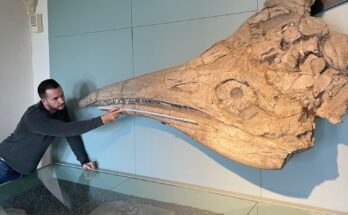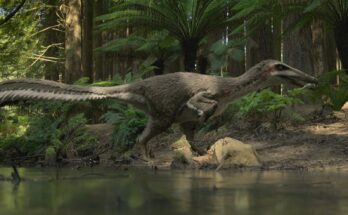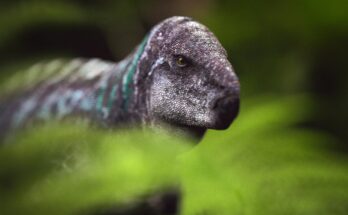✅ Part 1: Introduction — The Sea Monster Awakens
Imagine standing on the shores of a vast, ancient ocean 82 million years ago. The waves crash gently, but beneath the surface, something massive lurks. A shadow glides silently through the water. Suddenly, with explosive force, a giant reptile bursts from the depths and devours its prey in one terrifying gulp. This is Mosasaurus, the true sea monster of the prehistoric world.
The Mosasaurus wasn’t a dinosaur, but it lived alongside them. It was a marine reptile, a distant cousin of modern-day lizards and snakes, and one of the most dominant predators in the ancient seas. With a body stretching up to 50 feet (15 meters), jaws filled with dagger-like teeth, and a powerful tail built for swimming, Mosasaurus was the T. rex of the ocean — and it ruled the water with no mercy.
Today, Mosasaurus is one of the most famous prehistoric creatures, especially thanks to its dramatic appearance in movies like Jurassic World, where it leaps from the water to snatch a shark from a crane. But its real story is even more fascinating — a tale of evolution, dominance, and extinction. Unlike many other sea reptiles, Mosasaurus adapted quickly and successfully to a fully aquatic lifestyle, becoming the top predator in the oceans of the Late Cretaceous.
What made Mosasaurus so successful? How did it rise to power, and what did it eat? How did it interact with other marine reptiles like plesiosaurs and ichthyosaurs? And what led to its sudden disappearance?

In this article, we will dive deep into the story of Mosasaurus — its origin, evolution, behavior, and lasting legacy. Whether you’re a paleontology enthusiast or a casual fan of ancient giants, you’re about to discover the thrilling world of one of Earth’s greatest predators.
Let’s begin the journey back to a time when monsters ruled the sea — and Mosasaurus was king.
🦴 Part 2: The Discovery of Mosasaurus — The Fossil That Started It All
The story of Mosasaurus doesn’t just belong in prehistory — it also marks a huge turning point in the history of science. In fact, the very discovery of Mosasaurus fossils helped shape modern paleontology, and it happened long before the word “dinosaur” was even invented.
🧭 The Discovery in a Dutch Quarry (Late 1700s)
Our story begins in the late 18th century, near the city of Maastricht in the Netherlands. At the time, workers were mining chalk from underground quarries when they stumbled upon an enormous, mysterious skull. It had long, sharp teeth and a huge jaw. It looked nothing like any living animal.
Word quickly spread about the strange fossil. The skull eventually ended up in the hands of scientists — and one of the first to describe it was Georges Cuvier, a French naturalist. Cuvier was one of the first people to understand that this fossil belonged to an animal that was completely extinct — a revolutionary idea at the time!
He named the animal Mosasaurus, which means “Lizard of the Meuse River.” The Meuse (or “Maas” in Dutch) flows through Maastricht, near where the fossil was found. Although it looked like a crocodile or lizard, Cuvier recognized that it must have lived in the sea. This idea helped change how scientists understood extinction, evolution, and ancient life.

🔍 The Fossil that Changed Everything
The original skull, known as Mosasaurus hoffmannii, is still one of the most important fossils in the world. It showed:
- A long snout with sharp, conical teeth
- A robust, deep skull, good for crushing prey
- Features that linked it to lizards, not fish or dinosaurs
At the time, no one had ever seen a fossil like this. Many people believed that the Earth was only a few thousand years old, and that animals didn’t go extinct. But Mosasaurus proved otherwise. It was a creature that had once ruled the seas but was now long gone — evidence of an entirely different world.
🦎 What Kind of Creature Was This?
Early scientists debated what kind of animal Mosasaurus was:
- Was it a giant crocodile?
- A type of whale?
- Some even thought it was a kind of fish!
But as more fossils were discovered in other parts of Europe and North America, the picture became clearer. Mosasaurus was a marine reptile, related to modern monitor lizards and snakes. It had adapted to live full-time in the ocean, like today’s whales or dolphins.

🌎 The Spread of Mosasaur Discoveries
After the first Mosasaurus skull was found, more mosasaur fossils began turning up around the world — especially in the United States, in places like:
- Kansas (which was once covered by a shallow sea)
- Texas
- Alabama
- New Jersey
These fossils came from various species of mosasaurs, not just Mosasaurus hoffmannii. Some were small, around 10 feet long. Others were gigantic, reaching over 50 feet. Scientists realized that Mosasaurus was just one member of a much larger family of sea reptiles — the Mosasauridae.

🧬 A Window into Prehistoric Oceans
The discovery of Mosasaurus did more than just introduce a new species. It opened a window into an entire underwater world — one where reptiles ruled the seas, just as dinosaurs ruled the land.
Thanks to Mosasaurus:
- Scientists began to study marine ecosystems of the Cretaceous
- They learned about extinction and evolution
- It inspired generations of paleontologists
And it all started with a mystery skull in a Dutch chalk mine.
🏛️ Where Is the First Mosasaurus Skull Now?
The original fossil of Mosasaurus hoffmannii can be seen today at the National Museum of Natural History in Paris, France. It’s one of the most important specimens in paleontological history — a true icon of science.
In the next section, we’ll dive into the body of the beast. What did Mosasaurus look like? How was it built to dominate the seas? Let’s break down its anatomy and adaptations.


